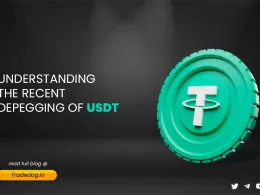Quick Links
- What is a Divergence Cheat Sheet?
- Understanding Divergence
- How to Identify Divergence?
- Trading Strategies Using Divergence
- Divergence Cheat Sheets for Different Indicators
- Limitations of Divergence Cheat Sheets
- Tips for Using Divergence Cheat Sheets Effectively
- Conclusion:
- FAQs of Divergence in Technical Analysis
Are you tired of those predictable textbooks claiming to provide you with insider secrets to successful trading? Or perhaps those hordes of complex trading jargon that can be overwhelming for a beginner or an experienced trader alike? If you’ve been searching for a simple yet powerful guide that isn’t overloaded with unnecessary fluff, you’ve finally arrived at the right place!
In this engaging and easy-to-follow guide, we will shine a light on one of the most crucial aspects of trading – divergence. We’ll dive headfirst into understanding its significance in technical analysis and how it can give you an edge in the competitive trading world.
What is a Divergence Cheat Sheet?
This quick reference guide highlights the various trading divergence patterns that may appear on a chart. Divergence occurs when an asset’s price and an indicator, like the Relative Strength Index (RSI), move in opposite directions. This pattern can provide traders with valuable information about potential price reversals or changes in trends.
The purpose of the divergence cheat sheet is to help traders identify these patterns and make informed decisions about their trades. A cheat sheet on hand saves time and reduces the risk of missing key signals in fast-paced trading.
Using a cheat sheet in trading offers several advantages. Firstly, it helps traders stay organized and focused. Traders can easily recognize signals and make informed decisions by providing a clear and concise overview of divergence patterns. Secondly, cheat sheets reduce errors and increase accuracy.
Many types of divergence cheat sheets are available, each with unique features and benefits.
- The MACD Divergence Cheat Sheet provides a visual guide to MACD divergence patterns, including bullish and bearish divergences, and tips on trading these patterns effectively.
- The RSI Divergence Cheat Sheet highlights different RSI divergence patterns, such as hidden bullish and bearish divergences. It provides traders with key insights into identifying and trading these patterns.
The divergence cheat sheet is invaluable for traders looking to improve their trading strategies. It provides quick and easy access to vital information about divergence patterns and helps traders stay organized, focused, and accurate. Why not try it and see how a cheat sheet can elevate your trading to the next level?
Understanding Divergence
Divergence is a term used in technical analysis. It refers to the phenomenon where the price movement of an asset and an indicator move in opposite directions, suggesting that there is an anomaly and should be considered. This occurrence can signal traders a potential reversal or change in trend.
There are two types of divergence: regular and hidden. Regular divergence is when the price of an asset makes a higher high or a lower low, while the indicator shows the opposite. Hidden divergence, on the other hand, is when the price of an asset makes a lower high or a higher low, while the indicator shows the opposite.
So, what causes divergence in trading?
Well, it can be caused by various factors, such as changes in market sentiment or shifts in supply and demand. For example, when prices continue to rise, but the indicator starts to decline, it could indicate that the market is becoming overbought and that a reversal may be imminent.
Another cause of divergence is a lack of confirmation between price trends and volume. When an asset’s price increases but the volume decreases, it could suggest that the buying pressure is waning, and a reversal may be on the horizon.
Understanding divergence is essential for traders as it can provide valuable insights into potential changes in market trends. By recognizing and analyzing the different types of divergence, traders can make informed decisions and develop more effective trading strategies.
How to Identify Divergence?
Feeling like you’re missing out on lucrative trading opportunities? Detecting divergence can give you a competitive edge!
Divergence is an effective method that can offer traders significant insights into market trends and potential price reversals. Divergence indicators such as the Moving Average Convergence Divergence (MACD), the Stochastic Oscillator, and the Relative Strength Index (RSI) are commonly used.
So how do you pinpoint divergence?
Here are the steps to follow:
Step 1: Select an indicator that can detect divergence. While momentum indicator like RSI is popular, the Stochastic Oscillator or MACD can also be used.
Step 2: Look for discrepancies between the indicator and the price action. Regular divergence arises when the price and the indicator move in opposite directions. Hidden divergence arises when the price and the indicator move in the same direction but at different rates.
Step 3: Monitor the direction of the trend. Divergence can indicate a trend reversal, so keeping track of the current market trend is important.
Step 4: Use other technical analysis tools to confirm the signal. Since divergence is only one aspect of the puzzle, it’s necessary to use other indicators to substantiate your trading decision.
Now that you understand how to identify divergence let’s examine examples of divergence on trading charts.
For instance, if the price of an asset is rising while the RSI is falling, this could indicate a regular bearish divergence. Conversely, if the price decreases while the RSI increases, this could indicate a regular bullish divergence. A hidden bullish divergence occurs when the price creates lower lows while the RSI is creating higher lows, and a hidden bearish divergence occurs when the price is making higher highs while the RSI is making lower highs.
Trading Strategies Using Divergence
As a trader, it’s important to seek out an advantage in the market constantly. This could come in the form of a trading strategy that allows you to identify lucrative opportunities, even in turbulent market conditions. One such strategy that has grown in popularity among traders is utilizing divergence.
The Significance of Trading Strategies That Employ Divergence
The disparity in price and indicator can provide valuable insights to traders about possible market trends. By scrutinizing price movements and identifying divergence patterns, traders can make prudent trading decisions and gain the upper hand in the market.
Examples of Trading Strategies That Employ Divergence in Trading Charts
Let’s examine some examples to grasp better how divergence can be used as a trading strategy. In a bullish divergence scenario, a security’s price is trending downward, but the RSI indicator is moving upward. This signifies that the trend may be on the verge of reversing, and a bullish trade could be made. A security’s price is trending upward in a bearish divergence scenario, but the MACD indicator is moving downward. This indicates that the trend may be about to reverse, and a bearish trade could be made.
Divergence Cheat Sheets for Different Indicators
Keeping track of various technical indicators can be challenging as a trader, especially in volatile markets. However, using cheat sheets for different indicators can help you easily identify profitable trading opportunities. Here are some cheat sheets for popular technical indicators and how to use them effectively.
Cheat Sheets for RSI, MACD, Stochastic Oscillator, and Other Technical Indicators
The Relative Strength Index (RSI), Moving Average Convergence Divergence (MACD), and Stochastic Oscillator are some of the most popular technical indicators traders use. Cheat sheets for these indicators provide a quick reference guide to identify divergence.
Explanation of How to Use Each Cheat Sheet
Using the cheat sheet for the RSI indicator, traders can look for divergence between the price action and the RSI line. In bullish divergence, the security price is moving downwards, but the RSI line is moving upwards. This suggests a potential reversal in the trend and can be used to make profitable trades. In bearish divergence, the security price is moving upwards, but the RSI line is moving downwards, indicating a potential trend reversal.
Similarly, traders can use the MACD cheat sheet to identify potential reversals or continuations in the trend. A bullish divergence occurs when the security price moves downwards, but the MACD histogram moves upwards. This suggests that the downtrend is losing momentum, and the price will likely reverse upwards. A bearish divergence occurs when the price moves upwards, but the MACD histogram moves downwards, indicating a potential downtrend reversal.
The Stochastic Oscillator cheat sheet helps traders identify overbought and oversold conditions. The price is moving downwards in bullish divergence, but the Stochastic Oscillator line is moving upwards, suggesting a potential bullish reversal. The price is moving upwards in bearish divergence, but the Stochastic Oscillator line is moving downwards, indicating a potential bearish reversal.
Remember that using cheat sheets is just one aspect of trading, and traders should use other technical and fundamental analysis tools to comprehensively understand the market.
Limitations of Divergence Cheat Sheets
Divergence cheat sheets are essential for traders looking to identify potential trading opportunities. These cheat sheets provide a quick and easy reference for traders to analyze price movements and technical indicators. However, relying solely on divergence cheat sheets can have its limitations.
Disadvantages of Relying Solely on Divergence Cheat Sheets
One of the primary disadvantages of relying solely on divergence cheat sheets is the risk of false signals. While divergence is a reliable tool, it is not foolproof. False signals can occur when a temporary blip in the price or technical indicator does not represent a significant trend change. Relying solely on divergence cheat sheets can also lead to missed opportunities, as traders may overlook other important technical analysis signals.
Importance of Combining Divergence Analysis with Other Technical Analysis Tools
To avoid the limitations of relying solely on divergence cheat sheets, it is essential to combine divergence analysis with other technical analysis tools. By combining technical analysis tools, traders can confirm potential trends and reduce the risk of false signals. For example, traders can use support and resistance levels, moving averages, and trendlines to confirm potential divergence signals. Combining different technical analysis tools can also provide a more comprehensive market picture and help traders make more informed trading decisions.
While divergence cheat sheets are valuable for traders, they should not be relied on solely. Combining divergence analysis with other technical analysis tools is important to reduce the risk of false signals and missed opportunities. By combining technical analysis tools, traders can gain a more comprehensive understanding of the market and make more informed trading decisions.
Tips for Using Divergence Cheat Sheets Effectively
Divergence cheat sheets can be helpful for traders, but like any tool, they must be used correctly to be effective. Here are some tips for using divergence cheat sheets effectively.
Best Practices for Using Divergence Cheat Sheets
First, it’s important to use reliable cheat sheets from reputable sources. Secondly, always remember that divergence is just one piece of the puzzle and should be used in conjunction with other technical analysis tools. Furthermore, use multiple timeframes to confirm divergence signals and increase the likelihood of success.
Common Mistakes to Avoid When Using Divergence Cheat Sheets
One of the most common mistakes traders make when using divergence cheat sheets is not factoring in market conditions. Divergence signals can be unreliable in extremely volatile or consolidating markets. Another mistake is relying too heavily on a single indicator, which can lead to false signals and losses.
Importance of Backtesting Trading Strategies Using Divergence Cheat Sheets
Finally, it’s crucial to backtest trading strategies using divergence cheat sheets before implementing them in actual trading. This allows traders to evaluate the strategy’s effectiveness over a range of market conditions and identify potential weaknesses.
By following these tips, traders can use divergence cheat sheets effectively and increase their chances of success in the market.
Conclusion:
In conclusion, the ultimate divergence cheat sheet can be incredibly valuable for traders looking to identify profitable trading opportunities. By understanding the key concepts behind divergence and how to use cheat sheets effectively, traders can gain valuable insights into market trends and make informed trading decisions.
However, it is important to remember that divergence analysis should not be relied upon as the sole indicator for making trades. It is always best to incorporate other technical analysis tools and thoroughly backtest trading strategies before making any decisions.
Incorporating divergence analysis into your trading strategy can help you gain an edge in the market and increase your chances of success. By following the best practices for using divergence cheat sheets and avoiding common mistakes, traders can improve their overall trading performance and achieve their financial goals.
FAQs of Divergence in Technical Analysis
- What is a divergence in trading?
In trading, divergence occurs when the price of a security moves in a different direction than a technical indicator. This can provide valuable information to traders about potential market trends.
2. What is the purpose of a divergence cheat sheet?
The purpose of a divergence cheat sheet is to provide traders with a quick reference guide for identifying potential divergence patterns using various technical indicators.
3. How do I use a divergence cheat sheet?
To use a divergence cheat sheet, traders need to identify the technical indicator and the type of divergence they are looking for, then locate the corresponding pattern on the cheat sheet.
4. What are the most popular trading strategies using divergence?
The most popular trading strategies using divergence are reversal divergence and trend continuation divergence. Reversal divergence occurs when the price of a security is moving in one direction, but the indicator is moving in the opposite direction. Trend continuation divergence occurs when the price and the indicator move in the same direction but at different rates.
5. Can I rely solely on divergence cheat sheets for trading?
No, traders should not rely solely on divergence cheat sheets for trading. It’s important to incorporate other technical analysis tools and consider market fundamentals before trading.
6. What are some best practices for using divergence cheat sheets?
Some best practices for using divergence cheat sheets include understanding the limitations of using cheat sheets alone, using multiple indicators to confirm potential divergence patterns, and backtesting trading strategies.
7. How important is backtesting when using divergence cheat sheets?
Backtesting is very important when using divergence cheat sheets because it helps traders determine the effectiveness of their trading strategies in different market conditions.









